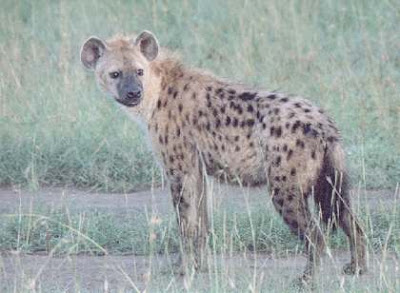Beauty Of Animal | Hyena | The spotted hyena (Crocuta crocuta) also known as laughing hyena, is a carnivorous mammal of the family Hyaenidae, of which it is the largest extant member. Though the species' prehistoric range included Eurasia extending from Atlantic Europe to China, it now only occurs in all of Africa south of the Sahara save for the Congo Basin. Spotted hyenas live in large matriarchal communities called clans, which can consist of up to 80 individuals.Though often mislabeled as cowardly scavengers, spotted hyenas derive the majority of their nourishment by hunting medium sized ungulates, and frequently clash with lions over food and territory. They are highly intelligent among the carnivora, with studies indicating that their social intelligence is on par with some primate species.The spotted hyena features prominently in African mythology and folklore, where its portrayal varies from being a bringer of light, to a symbol of immorality and depravity.It is thought that the ancestors of the spotted hyena branched off from the true hyenas (striped and brown hyenas) during the Pliocene era, 5.332 million to 1.806 million years ago.
Ancestral spotted hyenas probably developed social behaviours in response to increased pressure from rivals on carcasses, thus forcing them to operate in teams. Spotted hyenas evolved sharp carnassials behind their crushing premolars, therefore they did not need to wait for their prey to die, as is the case for brown and striped hyenas, and thus became pack hunters as well as scavengers. They began forming increasingly larger territories, necessitated by the fact that their prey was often migratory, and long chases in a small territory would have caused them to encroach into another clan's turf. The evolution of pack behaviour in hyenas likely influenced the ancestors of lions into first forming prides, in order to better defend their kills. According to the fossil record, the species first evolved in the Indian Subcontinent.
Spotted hyenas colonized the Middle East, Africa and the Ice Age plains of Eurasia extending from Atlantic Europe to China where a large subspecies known as C. c. spelaea or "cave hyena" developed as a response to the cold climate. Naturalists and paleontologists originally assumed that the cave hyena was a separate species from the spotted hyena, due to large differences in fore and hind extremities. This was first put into question by Björn Kurtén, who stated “ there is evidence that this European population was continuous with southern, typical representatives of the nominate subspecies”. This was corroborated by genetic analysis' in 2004, showing no differences in DNA between the two populations.With the decline of grasslands 12,500 years ago, Europe experienced a massive loss of lowland habitats favoured by cave hyenas, and a corresponding increase in mixed woodlands. Cave hyenas, under these circumstances, would have been outcompeted by wolves and humans which were as much at home in forests as in open lands, and in highlands as in lowlands. Cave hyena populations began to shrink after roughly 20,000 years ago, completely disappearing from Western Europe between 14–11,000 years ago, and earlier in some areas. The spotted hyena only vanished from the Middle East in the early Holocene around 8000 years ago, and was replaced in this region by the striped hyena. Since then, it has been confined to Sub-Saharian Africa.
Find Here The Kinds Of Animals and Flora and Fauna















